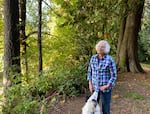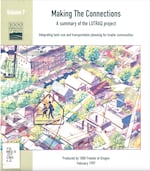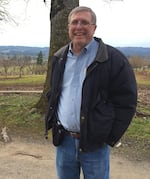OPB senior political reporter Jeff Mapes spent more than a year researching, reporting and producing “Growing Oregon,” a six-part podcast and web series looking at the evolution of Oregon’s unique approach to growth and the impact it has on our lives today. Here’s the story behind the story. In Part 1 we visited a time when Oregon’s farms and scenic beauty were under attack. In Part 2, we told the story of how Oregon leaders managed to write the state’s unique and controversial growth limits. In Part 3, we told the story of how unlikely activists pushed Oregon to mandate quality housing for everyone. Listen to Part 4:
One August evening in 1989, Meeky Blizzard, her husband Dave and two of their children were headed to their rural home not far from Beaverton, Oregon.
As they crested a nearby hill, they could see smoke and flames in the distance. They joked that it probably involved neighbors embroiled in a property dispute.
But as they drove closer, they realized it was their land. Flames shot up through the Douglas Firs that surrounded their home. The road was in flames, fire trucks were everywhere. They feared the worst.

Meeky Blizzard at her rural home along the Tualatin River in October 2021.
Jeff Mapes / OPB
“When we came home we thought, ‘Everything’s gone,’” Blizzard said.
They lost two barns and a small cabin, four motorcycles and two cars. The windshield literally melted off one.
But they were also lucky. Thanks to a recent rain that dampened the ground, the fire didn’t spread to their house. Even their goats and other animals survived.
Fire investigators found clear signs of arson. Somebody had poured fuel on the barn floor, set it on fire and slipped away. Police never found out who did it.
But Blizzard believes she knows why.
“All we can figure is that someone did that to dissuade me from my political action,” she said. “We’d never had anybody want to harm us before.”
Blizzard had become the leading face of political opposition to a proposed freeway that would have run along the fringes of Washington County’s suburban fringe.
Known as the Westside Bypass, the 20-mile freeway was ardently sought by the county’s business and political leaders.
But their freeway-building vision clashed with Oregon’s pioneering new growth management system — those rules about where and how land could be developed.
That fire at Blizzard’s rural home highlighted the bitterness over the proposed freeway. The battle wound up having an impact that spread far beyond this one stretch of road.
It put a new focus on how to make suburbs less dependent on cars. And it led to new rules under Oregon’s growth management system that affect how we live and travel throughout Oregon.
Freeways equaled freedom, to some
After Oregon adopted its new growth management system in the 1970s, the highway builders had little reason to think it would be anything but business as usual for them. In the early years of the system, the big fights focused more on protecting farmlands and development rules for housing.
The nation was continuing to expand the interstate freeway system — work that began in the 1910s but picked up its true champion under President Dwight Eisenhower in the 1950s — still the largest public works project in American history.
In the 1960s and 1970s, most of the big metropolitan areas of the country were building beltways. This was the time of “white flight,” when the suburbs grew rapidly and many Black residents were left to grapple with decaying urban neighborhoods.
Beltways were sold as a way to literally cruise above it all, or as General Motors once put it in a promotional film, they’re fulfilling “the American Dream of freedom on wheels….traveling on time-saving super-highways.”
The idea was that these beltways would help long-distance travelers avoid the congestion of the center city. They’d make it easier to get to all those new jobs and homes cropping up in the suburbs.

Interstate 205 runs through the Portland area’s eastside suburbs and up into Washington state, intersecting several major highways.
MacGregor Campbell / OPB
By the early 1980s, half of a beltway — Interstate 205 — was built through the Portland area’s east-side suburbs and up into Washington. And a lot of influential people wanted to complete the circle around the entire Metro area.
Highway planners had shelves full of proposals for the western half of a beltway. One idea from 1988 attracted the support of both Washington and Oregon officials. It called for a third freeway bridge over the Columbia River that would ultimately connect to the proposed Westside Bypass.
“This serves the same purpose as Interstate 205 does on the eastside,” one Washington County planning official told The Oregonian that year. “It gets congestion out of the main routes.”
That plan also called for running this new freeway through the middle of Portland’s Forest Park and building a new bridge to take it over the Willamette River.
So a full beltway was the grand plan lurking somewhere in the background. However, in the late 1980s, just one section of the loop had been turned into a — if you’ll pardon the pun — concrete freeway proposal.
That’s the Westside Bypass. It would start at Interstate 5 near Tualatin and run on the edge of suburbia to Hillsboro and the Sunset Freeway.
Back then, Meeky Blizzard was working as a freelance technical editor while raising her family and tending goats on nearly five acres next to the Tualatin River.
She first heard about the Westside bypass from a nearby winery owner. The exact route of the freeway and how close it would get to her property wasn’t clear. But she didn’t like the idea of a huge corridor of asphalt and concrete tearing through the countryside.
“People said, ‘You can’t fight city hall,’” Blizzard recalled. “And I said, ‘Well, maybe not, but I’m too young to roll over and say, there’s nothing I can do.’”
To her, the project seemed ill-conceived.
“First of all, it was outside the urban growth boundary,” she said, “and it would cut through a lot of prime farmland in Washington County.”
She wasn’t impressed by the traffic analysis showing time savings. She suspected local officials were more interested in opening up additional land for development as the county’s tech industry boomed.
“They eyed all this open land between Tualatin and Hillsboro,” Blizzard said, “as potentially vacant and as available for housing.”

This map is based on a 1988 study showing the planned corridor for a new freeway on the western fringes of urban Washington County. Known as the Westside Bypass, it would have run from Interstate 5 in Tualatin to Hillsboro and the Sunset Highway. The freeway was killed before an exact route was determined.
MacGregor Campbell / OPB
Westside Bypass boosters insisted they didn’t want to enable more suburban sprawl.
“This facility is not intended, nor will it be designed to encourage new development outside of the urban growth boundary,” then-Washington County Chairwomen Bonnie Hays said at the time. She talked about limiting the freeway entrances and exits as the road went through farmland.
The first serious opposition to the freeway came from 1000 Friends of Oregon, the watchdog group that pushed for strong growth controls. The nonprofit launched a legal battle against the freeway. Robert Liberty, a lawyer for 1000 Friends, said it was Blizzard who argued for — and launched — a grassroots organizing effort.
Liberty called Blizzard “a hippie from Maine” who blossomed in her new role.
“She had some good instincts about dealing with people,” he said. “The woman met the moment, you could say.”
Blizzard recruited Portland activists who had successfully fought against the Mount Hood Freeway, which would have destroyed hundreds of homes in the city. Out in the suburbs, she set up booths at fairs and farmer’s markets. And she talked to any civic group that would listen.
She was particularly struck by the former Californians who frequently approached her.
Blizzard said they’d talk about how often they were promised back in the Golden State that just one more freeway would end congestion. The freeway would get built and congestion wouldn’t end. “They said, ‘We don’t want that to happen here, so we’re with you,’” Blizzard recalled.
That’s a folksy way to describe the concept of induced demand. Experts use the term to describe the main problem that accompanies highway expansion. More road space leads to more driving and more car-dependent development, several studies have shown. In the end, the result is more congestion.
Blizzard frequently found herself at the same forums arguing these and other points with Mary Tobias, who headed a local economic development group. “I enjoy her,” Tobias told The Oregonian in 1989. “But I do not appreciate the obstructionism.”
Supporters would invariably paint critics like Blizzard as stubborn opponents of progress. Why couldn’t they see the need for new roads? After all, the rapid expansion of the highway network brought us growth and prosperity for decades. Washington County — with Nike and Intel and other big firms — was rapidly turning into the state’s primary economic engine, and people and goods needed to get around.
Stopping the bypass is “going to cause gridlock, headaches and problems for the state,” said Bill Moshofsky, who headed a group critical of the state growth controls. “We want flexibility and realistic growth.”
Critics, seeing the bypass as another driver of urban sprawl, leaned heavily on Oregon’s growth management system to press their legal case.
1000 Friends filed lawsuits arguing that Washington County and Metro — the Portland area’s regional government — couldn’t move forward on the bypass without first showing that it didn’t conflict with the growth system’s goals.
Keith Bartholomew was then a young attorney who worked on the case for 1000 Friends. The lawsuits, he said, were aimed at forcing transportation and county officials to think more broadly, not just blindly follow traffic projections.
“They’re assuming that — more or less — what we have seen for the past 20 years is going to extend itself for the next 20 years,” Bartholomew said. “And that’s where we started to ask questions…If we don’t like what we’ve done for the past 20 years, then why would we plan on continuing it?”
1000 Friends won the first round in court. That sent shivers through the freeway builders.
Retired Portland State University planning professor Ethan Seltzer was once a Metro staffer. He remembers a meeting with a top Oregon Department of Transportation official as participants argued at length over just how the growth system would affect the bypass.
Finally, Seltzer said, the official “slams his hand on the table and says, ‘Goddammit, doesn’t anyone want to build anything anymore?’”
Opponents were interested in building something — a different kind of suburb.
Building better
By 1990, the Westside Bypass was in limbo. The legal fight continued as the state transportation department conducted a new study of the project.
1000 Friends decided it was time to take a different tack. Filing lawsuits wasn’t enough.

A study commissioned by 1000 Friends of Oregon sought to show how Washington County could change its development patterns to reduce driving, thus removing the need for a new freeway.
Screenshot of LUTRAQ study / OPB
“This needed to be not just about stopping something destructive,” Bartholomew said, “but helping articulate something positive, and to help promote that.”
In other words, how do you accommodate growth in a way that doesn’t have everyone in their car all the time?
“There’s gotta be,” said Bartholomew, “a better way to build a suburb.”
That’s what 1000 Friends set out to attempt. They raised more than $1 million to hire experts from around the country to figure out how they could literally re-make Washington County so that people would be less reliant on driving.
Bartholomew said nobody had ever done quite what they set out to do. They called their study “Making the Land Use Transportation Air Quality Connection,” or LUTRAQ for short.
The LUTRAQ study wound up proposing some pretty big changes. It called for dense developments around the light rail line then under construction from downtown Portland to Hillsboro. The experts assembled by 1000 Friends wanted fewer cul-de-sacs in subdivisions so that neighborhoods would better connect with each other. It was part of making walking and bicycling more attractive.
They also took aim at the very foundation of suburban living: free parking. They suggested that solo commuters pay for their parking spaces at work.
Essentially, they wanted suburbs to look more like real cities.
The experts developed sophisticated computer programs showing how their approach would affect traffic. They’d look at what would happen if you doubled the population around rail stations Or made it financially more attractive to carpool. And so on.
Bartholomew said the computer simulations showed even better results than its advocates expected.
“You find out there’s no need for a freeway,” he said. “You don’t have to spend that money. You don’t have to plow up that land or pave it over. You just need to build better.”
LUTRAQ attracted a lot of buzz — and a national award — in planning circles. LUTRAQ was also winning favor among a growing number of Portland area politicians.
As a result, the Westside bypass was deflating like an old balloon. Federal funding looked more doubtful than ever. Then-Governor Barbara Roberts weighed in against it in the early 1990s. That may have been the project’s final blow.
I asked Roberts about this recently. As it happened, a former 1000 Friends attorney, Bob Stacey, had been one of her aides. I asked her if he had her ear on what to do with the Westside Bypass.
“On this one, he had not only my ear, but my arm and my leg and everything else,” she shot back.
Eventually, the state transportation department and Metro came up with alternative plans that included a series of other road projects. Bartholomew and Blizzard watched from an empty hearing room as Metro formally buried the bypass in 1997.
The bypass “didn’t end with a bang,” said Batholomew, “it ended with a whimper. And then we went out and had a beer.”
Blizzard said they probably would not have been able to stop the bypass without Oregon’s growth controls. The new system gave opponents the legal underpinnings they needed.
A new standard for roads
Oregon’s original growth planning goals called for a balanced transportation system that shouldn’t rely too heavily on cars. This was during the Arab oil embargo, and everybody was worried about gas shortages. But by the 1980s, oil was cheap and plentiful. Nobody paid much attention to this goal.
The fight over the Westside Bypass changed that.
State officials realized they needed some firm rules to guide local governments in their transportation planning. A big part of that was encouraging compact development that would reduce motor vehicle use.
“They came up with state policies that actually had nothing to do with a bypass,” Blizzard said, “but the bypass forced the issue.”
The new transportation rule was adopted in 1991. It encouraged bicycling, walking and transit. Compact development should be more common, and local streets should be better connected with each other.
Most prominently, the rule said that urban areas should cut their vehicle travel by 10% over the next 20 years — and eventually by 20%.

Bradley W. Parks / OPB
Bob Cortright, who helped write the transportation rule for the Oregon Department of Land Conservation and Development, said that localities complained that the 20% cut was too hard to meet. So they revised the rule to call for only a 5% reduction. Even that smaller goal proved elusive.
“This should be the big red ‘wrong way’ sign on the freeway,” said Cortright, “telling us that we’re not getting there.”
Still, the state’s urban growth boundaries have helped keep down travel distances. In the Portland region, for instance, people on average drive about 23% fewer miles than residents of other large U.S. metro areas, according to 2019 figures from the Federal Highway Administration. In addition, the state and Metro are continuing other efforts to reduce driving — and to speed the shift to electric cars.
But what about that big LUTRAQ study that long ago showed how to get people out of cars?
A lot of it never happened or at least hasn’t happened yet. There are no required commuter parking fees. It’s a mixed record on denser development and connectivity between neighborhoods.
And most of all — like in so much of Oregon — people still depend on cars the vast majority of the time. Washington County officials say their latest numbers show that about 86% of trips in the county are by auto.
Even before the pandemic, ridership on the two light rail lines that go through Washington County was trending down. TriMet ridership figures showed that ridership peaked in 2012, with about 7.6 million passengers boarding a train in Washington County.
By 2019, the last year before the pandemic, ridership had dropped to about 6.6 million. WES, a separate commuter rail line between Beaverton and Wilsonville, has seen particularly anemic ridership. And all of this was happening while the county’s population continued to grow.
Rich Vial, a former GOP state legislator from Washington County, said getting people out of cars is a pipe dream.

Rich Vial, former Republican lawmaker and deputy secretary of state, near his home in 2018.
Lauren Dake / OPB
“The more trains we get and the more places they go,” he said, “it seems like the fewer people are riding them.”
Vial sponsored his own bill in the Legislature in 2017 to revive a much grander version of the Westside Bypass. He wanted to allow local governments to set up tollway authorities that could build their own roads. He hoped that could produce a tolled freeway that would break off west of Interstate 5 in northern Marion County, run through Washington County and then up into Washington state before reconnecting with I-5.
Vial also got the bill introduced in 2019, after he was out of the Legislature. Both times, it went nowhere.
For all of that, it’s not as if Washington County has abandoned drivers. The state and county have put hundreds of millions of dollars into expanding the local road system. And in 2017, the Legislature committed the money to widen Highway 217. That’s the county’s frequently congested north-south freeway.
The suburbs are changing. But it’s a mixed picture. Whether in Beaverton or the outskirts of Bend, you can find new developments that promote walking and bicycling. But I can also show you miles of overloaded boulevards passing one strip mall after another.
Retrofitting a suburb, it turns out, is hard. Blizzard said it’s easy to get discouraged. But then she will see a subdivision with a wide variety of homes surrounding a park. Or new shops placed so they are an easy walk from nearby homes.
“There’s some wonderful development,” she said, “little pieces of it here and there. Not as much as certainly, I would like.”
Blizzard still lives on her rural property — although the urban growth boundary has crept closer.
She and her husband long ago built a new barn to replace the ones that burned down. Five of the big fir trees were so damaged they had to be removed. But their property is still a wooded oasis. As we walk out the back of her house, we overlook the Tualatin River. A federal wildlife refuge is across the water. She said her land may someday become part of the refuge.
The fight over the Westside Bypass changed her life. She wound up working for Earl Blumenauer, both when he was a Portland city commissioner and then when he went to Congress.
Blumenauer sent her to more conferences on transportation and compact development than she can remember. It made Blizzard ponder about spending most of her adult life on that rural land. But this is home.
One irony, she said, was that she did more driving when she was fighting the Westside Bypass “than I’d ever done in my life.”
She’s since tried to reduce her impact on the road. In that new barn, she shows me a pair of small motorcycles.
“The one on the right is mine,” she said. “I got my motorcycle endorsement at age 73.”
When she received her DMV photo, the worker looked at her age. And then he cracked, “’This is great, what did you get — a Harley hog?’
“I said, ‘Well, it’s actually more like a piglet.’”
Her piglet, she added, is great for going to the grandkids’ soccer games.
Next week: How a little old lady nearly gutted Oregon’s growth rules. Property rights activists nearly derailed Oregon’s growth management system in the early 2000s. And no one was more prominent — or colorful — than Dorothy English.
The Growing Oregon audio story is available through the OPB Politics Now podcast feed.

OPB Sta
